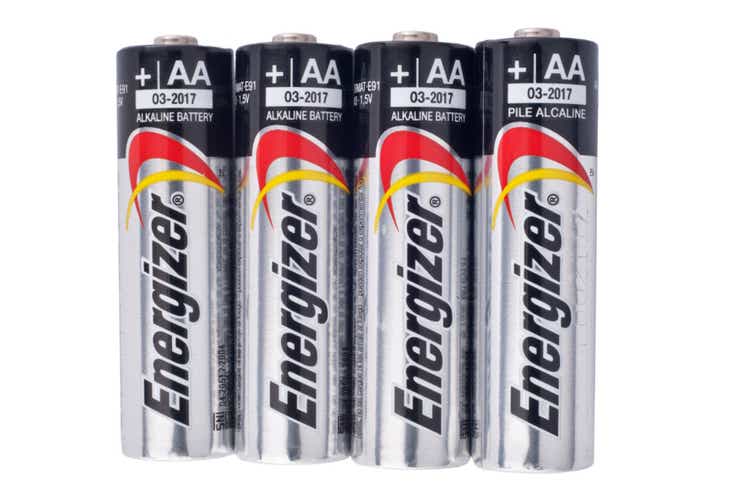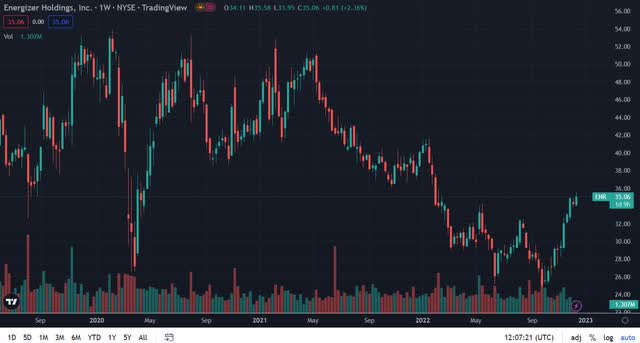oneclearvision
Energizer Holdings, Inc. (NYSE:ENR) has been on a tear since September 30, 2022, when it hit its 52-weeek low of $24.81. It since rebounded to the mid-$35s before falling back to a little above $35.00 per share as I write – a 40% gain under difficult macroeconomic and geopolitical conditions.
That said, Energizer has guided for a temporary decline in organic sales combined with higher cost of goods in the next couple of quarters, which, when combined with the rapid increase in its share price, could result in a significant hit to ENR stock, as shareholders may choose to take some profits off the table.
Volume in its battery category has been falling, down 12 percent in the fourth fiscal quarter of 2022, according to management. So far, that has been more than offset by the pricing power of the Energizer brand, which has allowed the company to raise prices by approximately 20 percent in the reporting period. How long that can keep up in a high inflation, high interest rate environment remains to be seen.
In this article, we’ll go over some of the latest earnings numbers, what the next couple of quarters are likely to look like, and what the long-term outlook for the company is.
Recent numbers
Revenue in the fourth fiscal quarter of 2022 was $790.4 million, up 3.19 percent year-over-year, beating estimates by $15.47 million. Organic sales in the reporting period were up 7.4 percent, a combined increase of about 13.3 percent in battery and auto care.
Gross margin in the quarter came in at 36.1 percent, down from the 36.5 percent in the fourth fiscal quarter of 2021. Gross margin for fiscal 2022 was 36.7 percent, down from the 38.4 percent in gross margin from fiscal 2021.
The decline in gross margin was attributed to higher operating cost inflation in materials, labor and transportation. The other negative impact came from inefficiencies associated with the reduction in production volume coming from shrinking its inventory levels.
The company expects to start fiscal 2023 with gross margin of about 37 percent to 38 percent and improve as the year goes on.
Net loss in the quarter was $(362.9) million, or $(5.09) per shares, primarily from a non-cash impairment charge of $541.9 million.
Adjusted net earnings were $58.5 million or $0.82 per share, slightly up from the $57.8 million or $0.79 per share in adjusted net earnings from the fourth fiscal quarter of 2021. Full-year adjusted net earnings were $221.1 million or $3.08 per share, down over $34 million from the full-year 2021 adjusted net earnings of $255.4 million or $3.48 per share.
Adjusted EBITDA in the fourth fiscal quarter was $146 million, up by about $10 million from the $135.9 million in adjusted EBITDA in the fourth fiscal quarter of 2021. Full-year adjusted EBITDA for the fourth fiscal quarter of 2022 was $567.9 million, down by about $53 million from the $620.3 million in adjusted EBITDA for full-year fiscal 2021.
SG&A for the fourth fiscal quarter was $119.2 million, or 15.1 percent of net sales, up from the $109.4 million in SG&A last year in the same reporting period, which was 14.3 percent of net sales. An increase in recycling fees and operational costs was the reason given for higher spend.
Free cash flow in the quarter reached $95.3 million.
The company had cash and cash equivalents at the end of the quarter of $205.3 million, with long-term debt of $3.5 billion. Management stated that paying down its debt is the priority of the company at this time. The company has no significant maturities until 2027.
A&P costs in the reporting period were 3.5 percent of net sales, and 4.5 percent of net sales for all of fiscal 2022. In 2023, the company is going to increase that to 5 percent to 6 percent of net sales.
For full-year fiscal 2023, adjusted EBITDA is projected to be in a range of $585 million to $615 million, with earnings per share of $3.00 to $3.30.
Share price and next two quarters
As mentioned earlier in the article, the share price of ENR has bounced strongly off its 52-weeek low of $24.81 on September 30, 2022 and is trading approximately 40 percent higher in that short period of time.
With the headwinds facing the company in the next couple of quarters, and the rather modest results in the fourth fiscal quarter, it looks to me like ENR is primed for a correction in the near term.
This is primarily from the costs of goods expected to increase in the first half of fiscal 2023, based upon the impact of production at “peak inflationary costs.”
It also reflects expectations that organic sales will be “down low single digits” in the first fiscal quarter, which when combined with higher costs of goods, will probably put downward pressure on the share price, especially after having such a strong run over the last 75 days or so.
Management stated:
Our cost of goods in the first two quarters will also reflect the impact of production at peak inflationary costs; and, to a lesser extent, the cost of operational inefficiencies as we produce lower volumes while actively managing down inventories at the end of last year.
For those reasons, I believe it’s inevitable that ENR stock goes through a correction before finding its feet once again.
Project Momentum
How I view ENR at this time is the most important strategy of the company over the next year or two is going to be “Project Momentum,” which has been implemented for the purpose of improving margins across the entirety of its business.
Over the next couple of fiscal years, the company expects the initiative to generate savings in the range of $80 million to $100 million. For 2023, the company guides for savings from the program to be from $30 million to $40 million.
The company pointed out that the savings from the program will have nothing to do with inflation during that time period. The point there is, the company is focusing on things it can control, not the macroeconomic conditions it has no control over.
Outside of the potential savings and improved margins, the key thing to take into consideration here is this isn’t a program designed to improve margins in general, but a program to recover margins to past levels. Management was clear on that when asked about whether or not it would boost margins in the future, meaning beyond past levels. The response was that there was no way of knowing that far into the future.
The emphasis and purpose of Project Momentum is margin recovery to past levels, not improving margins beyond that.
That’s another way of saying investors need to manage expectations as to what results the program is meant to produce.
Battery demand
The battery segment of ENR is by far the largest, and so will easily have the most impact on the performance of the company.
In regard to fundamentals for batteries, management stated that overall usage per household is up 15 percent when measured against pre-pandemic levels. It was also noted that device ownership is up 6 percent versus pre-pandemic levels, so growth in the battery category continues to rise.
Also, when queried about the potential for low-cost battery competition, the company said branding and quality in the segment is a priority for consumers. Management said that global private label battery sales were down 2 percent in share, while in the U.S. they were up 3.2 points in share. At the global level, ENR increased share by 2.5 percent.
Even though sales volume in batteries has been dropping, it has been more than offset by pricing power so far. That’s something to closely watch as inflation lingers, interest rates remain high, and the potential for the recession to deepen in calendar 2023.
The company expects volume to continue to fall in the first half of fiscal 2023, so it remains to be seen how much that will be able to be offset in light of potentially worsening economic conditions, considering prices have already been increased by 20 percent.
Conclusion
ENR is going to continue to grow revenue, but it’s going to be at a very modest pace.
After the recent 40 percent run in ENR’s share price, I don’t see anything in the performance of the company or remarks and guidance from management that suggests most things are already priced in.
With that in mind, I think ENR is likely to go through a correction in its share price, and it’s likely to trade lower in the first and second quarters of fiscal 2023, until we see how much higher costs will be in the two quarters, and how much lower sales will be during that period of time. I think the most important metric to watch is how much the company applied to debt, along with the level of free cash flow it’s able to throw off. If both of those are significant, the company could hold up better than expected if costs rise and revenue slows down in the first half of fiscal 2023. Looking ahead, interest rates are going to continue to rise, the U.S. dollar will remain strong, and the recession has a strong chance of getting worse in 2023.
Taking everything into account, I think the share price of ENR is too elevated and due for a breather. The best way to play it in my opinion will be to wait for a pullback before taking a position in the company because I don’t see there being much upside in the near term, and risk/reward isn’t in favor for those thinking of taking a new position in ENR. Longer term, I think Energizer Holdings, Inc. should do well. But even current shareholders, depending on the cost basis they have in the company, should consider maybe taking some profits off the table and wait for another entry point that would lower it.
For those already in at a low entry point, I don’t think there’s a risk in holding Energizer Holdings, Inc. for the long term, as demand should continue to rise in the years ahead.



Be the first to comment